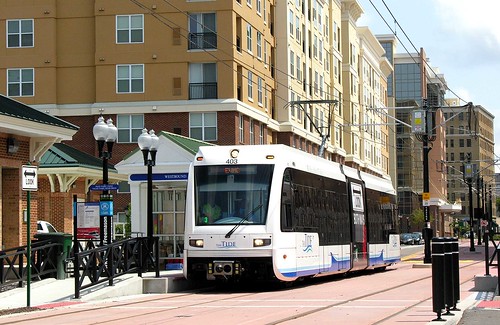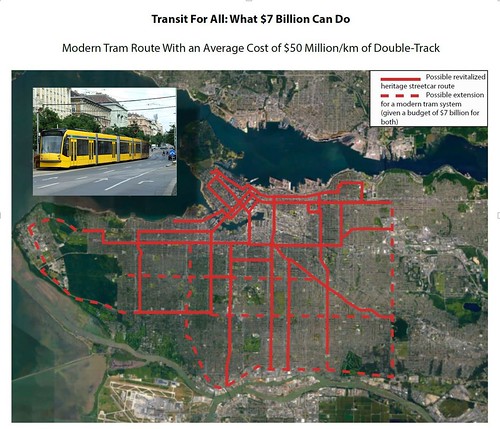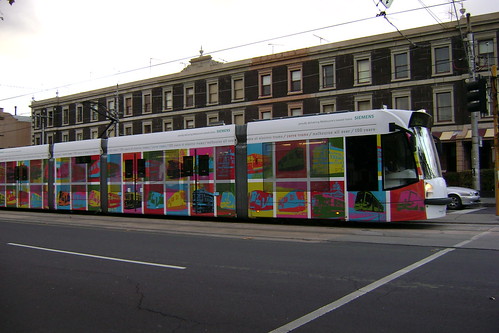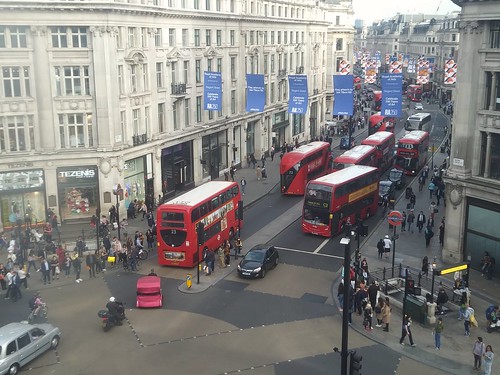A high-impact transit agenda: building alternative models of best practice
Recently I read a piece in the Bicycle Dutch blog about the first bicycle plan for the City of Delft in 1979. It was the first bike plan in the Netherlands post the re-commitment to bicycling that focused on building active ridership by focusing on the creation of a connected system, not so much on separated cycle infrastructure, but the creation of a network.
 Map from the Delft Cycle Plan showing the proposed cycle network. Left: the three levels explained. (From the archive of André Pettinga)
Map from the Delft Cycle Plan showing the proposed cycle network. Left: the three levels explained. (From the archive of André Pettinga)From the entry:
Delft was the third city in The Netherlands to experiment with modern cycling infrastructure, aided by the national government. After the experiments in Tilburg and The Hague in the 1970s, where they built one very good (but also very expensive) cycle route, that had mixed results but didn’t lead to more cycling overall, Delft took a different and innovative approach. Delft wanted to improve the city’s existing cycle network, which had a lot of missing links. ...Networks are key. Missing links have disproportionate negative effect on use.
“We were determined to get a good network of cycle routes, not necessarily all on protected cycle paths, because we knew we couldn’t afford that.” André tells me, “And we already had good experiences with traffic calming of roads and streets.” It may be good to realise that there was no ‘zero’ situation in Delft. The presumption was, there were parts of a network, but with many missing links. The network of the plan already existed for about 75% (this includes traffic calmed streets and cycling infrastructure on distributer roads). The modal share for cycling before the plan was already 38%. ...
The response of the survey, 72%, was very high and helped the city to identify the most important physical, financial and mental barriers to cycling in the city.
======
I am on an email list where one of the current discussions is the dropping of a light rail program for Raleigh-Durham, North Carolina as discussed most recently in CityLab ("Why Duke Killed the Durham-Orange Light Rail Project") and earlier in the month in the Raleigh News & Observer ("Light rail: Duke hasn’t been the only roadblock to the project").
A couple years ago I wrote a piece about (bus) transit in Raleigh-Durham, because the way the transit agencies work together is a more informal version of the German style transport association, which is something that the DC area should have. E.g., in R-D they have one customer call center for all the transit agencies, run by Triangle Transit (GoTriangle) whereas in the DC area, each transit agency does their own thing. It's a model for how metropolitan areas with multiple agencies should be collaborating.
-- "Will buses ever be cool? Boston versus the Raleigh-Durham's GoTransit Model," 2017
 Norfolk.
Norfolk.What's the right rail transit mode and paradigm for a community?
But even then I was a bit surprised at the proposal for light rail in the R-D area with a metropolitan population of 1.21 million.
Sure sure I favor rail transit, because of the nature of trips in the region and because of what we should rightly call massive failure of LR in places like Charlotte (fewer than 28,000 daily riders after a recent extension) or Norfolk (fewer than 7,000 daily riders although the line doesn't go to major activity centers in the area) in terms of ridership -- although sure the failure is partly due to truncated lines and the fact that these lines are single lines, not part of a network -- I've started to question willy nilly support for LR projects.
Even Dallas--93 miles of track, 64 stations, about 100,000 daily riders--considering, doesn't have all that much ridership considering the number of stations and investment. The Dallas Metropolitan area has a population of 6.8 million.
By contrast, the Minneapolis light rail system has 37 stations on two lines (one is in the process of being extended which will add 16 stations) totaling 23 miles of track and about 75,000 daily riders, complemented by a small commuter rail line, BRT, and local transit services. (Separately St. Paul is adding streetcar to the mix). The area population is 3.6 million
Doesn't it make more sense to invest monies for transit in those places where there can be significant impact?
So I've been thinking, besides straight up BRT--bus rapid transit, what kind of innovative, transformational transit services ought to be the focus of smaller communities, rather than more traditional LR systems.
Here are four primary ideas. Relatedly, I am starting to believe that it'd be better to focus on these improvements to the transit network now, rather than longer term plans to build longer distance high speed rail (HSR) lines, which seem to generate tremendous opposition.
1. City-wide streetcar networks. Professor Patrick Condon proposed that Vancouver should focus on streetcars as opposed to longer trip focused LR systems ("Why a Streetcar Is Something to Be Desired" and "Am I the Last Voice against SkyTrain to UBC? It will drive unaffordable condos in Vancouver. Which drives me nuts," The Tyee).
Note that I discuss this issue in terms of inter-city transit and intra-district rail transit ("DC and streetcars #2: STREETCARS ARE ABOUT TRANSIT, just in a different way from how most people are accustomed to thinking about it," 2015).
Subway extension in Vancouver

Or the creation of a streetcar network for the same amount of money, serving more people?

While I do think in Vancouver it isn't either/or but and/and, couldn't cities like Kansas City or Cincinnati or Oklahoma City, which have recently introduced a streetcar line, try to develop a deeper in-city streetcar transit network, as opposed to Light Rail? Or Nashville, St. Petersburg, Tampa, Arlington, Texas ("Arlington needs public transit. Here's how to do that," Fort Worth Star-Telegram), San Antonio, etc., as opposed to seeking to build light rail systems?
Although, note that this was proposed for DC too, but successive administrations haven't committed to it.
Wouldn't it be awesome as a demonstration to the rest of the country if we had a city in the US that functioned this way (comparable or smaller to how Zurich and Melbourne have streetcars as a key element of their transit system)? (Philadelphia has some lines but not a preponderance. Toronto doesn't seem to have the same breadth of streetcars as do Zurich and Melbourne.)
 The Melbourne tramway network has 160 miles of double track, 493 trams which are a mix of modern and "vintage" vehicles, 24 routes, and 1,763 tram stops.
The Melbourne tramway network has 160 miles of double track, 493 trams which are a mix of modern and "vintage" vehicles, 24 routes, and 1,763 tram stops.Melbourne.
Zurich has about 45 miles of double track and 60 miles of single track on 16 routes and 313 vehicles--a mix of old and new.
Both cities have other forms of rail and bus transit, and are leaders in the creation of special transit fare pass products designed to encourage choosing transit first and primarily for trips.
Like Zurich and Melbourne, in Vancouver you do probably need both heavier rail and streetcars. In Cincinnati you don't, or at least it's too hard to make it work even in the intermediate term given the reality of how the region has reorganized around the car over the past 70 years. In R-D and KC you do have interesting issues because of the polycentric nature (or at least duality) of those places.
2. Double decker bus lines. I've argued that we should use double deck buses as a way to rebrand and reposition transit. They are a lot more fun than the vehicles used in BRT systems. And they are visually striking. Far more than BRT vehicles ("Making bus service sexy and more equitable," 2012)
 A mass of buses on Regent Street at Oxford Circus, Westminster, London
A mass of buses on Regent Street at Oxford Circus, Westminster, LondonMost transit systems in the UK use double deck buses, although not exclusively. I argue that at the very least we need to test them ("The need for a double decker bus vs. streetcar comparison study," 2014).
A few North American jurisdictions, but primarily Ottawa City, Ontario, use double deck buses.
3. Better leveraging of existing passenger rail systems to provide service within cities. Most railroad passenger systems were developed to bring people from suburban and exurban areas to cities. Depending on how long ago they were developed, lines usually have a limited number of city stations, other than the primary hub.
Cities like Chicago ("Instead of extending the Red Line, some see promise in the Metra Electric," Chicago Reporter), New York, Boston ("More trains mean equity for Fairmount Line," Boston Globe, Baltimore, and DC have opportunities for in-city transit stations on these lines.
The models for how to do it include the German S-Bahn system, which is a "suburban" rail program designed to integrate with and extend city subway and related transit systems, the London Overground ("One big idea: Getting MARC and Metrorail to integrate fares, stations, and marketing systems, using London Overground as an example," 2015), or the RER system in Greater Paris.
This necessitates creating better connections between often disconnected "terminals" or improvements within existing stations to facilitate rail line connections, like at Millennium Station in Chicago, which will allow increased service from Indiana's South Shore Line.
For example, between Penn and Grand Central Stations in Manhattan or between North and South Stations in Boston. A model for how to do this is the Center City Commuter Connection in Philadelphia, which connected three different train stations, allowing for train lines from different systems to be integrated.
There are many opportunities to make these kinds of improvements, which would have an extranormally positive effect on ridership and effectiveness.
4. (Re)creating regional rail/intra-state rail networks. Last week, the Wall Street Journal ran a long piece about "the waste" of $2 billion on improved rail systems between Chicago and St.Louis, because the speed improvement of an end to end trip is seemingly minimal ("High-Speed Rail in the U.S. Remains Elusive: Illinois Shows Why"). But Rail Passengers Association ran a good op-ed in their blog making the point that focusing on the Chicago to St. Louis trip missed the point in terms of the significant improvements experienced on sub-line trips, say Chicago to Bloomington.
In 2017, I went to the annual meeting of the Virginia Association of Rail Patrons and there was an interesting presentation by Rafael Guroian who pointed out the missed links in having a true intra-state regional rail network in Virginia, how college students are a significant proportion of rail ridership, etc., and how these links could be created. But the state's rail plan doesn't prioritize addressing such gaps.
 While this is a map produced by VARP from "Statement on Future Rail Passenger Service in the Virginias (Draft)," it's similar, and the red lines show missing links in an intra-state rail network.
While this is a map produced by VARP from "Statement on Future Rail Passenger Service in the Virginias (Draft)," it's similar, and the red lines show missing links in an intra-state rail network.I have been only to a couple places in Europe, but wrt rail it's super interesting about how virtually all the writing about UK rail is that it is a disaster post-Beecham cuts (1960s) and privatization.
But for all the writing about how disastrous UK rail is, as a system it is probably a minimum 10X better than what we have in the US in terms of the ability to get to many places from many places on a frequent basis.
It helps that it's easier to do rail in the UK (or Germany or France) because relatively speaking the country is small and therefore so the distances between major cities are short which works in favor for rail transit.
Maybe rather than HSR, we should be focusing on rebuilding these kinds of networks at the regional scale.
Other elements to focus on include:
-- BRT, but as integrated networks, rather than a bunch of competing systems (e.g., in the DC area, WMATA, Montgomery County, and Fairfax County are all doing their own thing)
-- a focus on creating high quality transit stations and conceiving them as a network and investing in transit stops and stations more generally as they are the marketing touchpoints for transit and communicate whether or not a community values transit to begin with
-- bundling local transit access with rail tickets (Metrolink does this probably the best in the US, the QR code on the ticket works as an equivalent of the TAP card, but MARC does this too, with local transit in Greater Baltimore, and WMATA and Montgomery County bus, PATH uses the NYC Subway card, in North Carolina, Amtrak riders can use local transit for no extra charge, etc.)
-- having common transit fare media systems across a state. E.g., the Presto system in Ontario is supposed to be usable in all but one of the provinces major transit agencies. The CharlieCard in Mass. is used by many of the state's transit agencies. The DC area SmarTrip card also works in Baltimore and vice versa as Baltimore's CharmCard is merely a branded version of the SmarTrip card.
And importantly, especially in cross-state areas like DC-MD-VA and NJ-NY, create German style transport associations
-- "The answer is: Create a single multi-state/regional multi-modal transit planning, management, and operations authority association," 2017
-- "Verkehrsverbund: The evolution and spread of fully integrated regional public transport in Germany, Austria, and Switzerland,"Ralph Buehler, John Pucher & Oliver Dümmler, International Journal of Sustainable Transportation (2018)
-- Transport Alliances - – Promoting Cooperation and. Integration to offer a more attractive and efficient Public Transport, VDV, trade association for German transport associations
But take them to the next generation by integrating for profit mobility providers as well:
-- "Another example of the need to reconfigure transpo planning and operations at the metropolitan scale: Boston is seizing dockless bike share bikes, which compete with their dock-based system," 2018
Labels: capital planning and budgeting, fixed rail transit service, transit infrastructure, transit marketing, transportation planning



4 Comments:
Condon’s tram concept is silly. There is zero reason to invest that much money in transit only to create nothing but small, slow, mixed traffic streetcars.
Conversely, all of the cases where cities retain their tram networks are historic. Nobody would recreate those kinds of networks today, because the replacement cost is extremely high and the benefits are quite low. It’s telling that modern tramways are a) not nearly as extensive, and b) utilize dedicated rights of way wherever possible.
Long story short, Vancouver is making the right choice to build a subway.
Condon’s argument is a nice bit of nostalgia. If we never ripped out those streetcars, they’d be useful to have today. But they’re not worth replicating.
FWIW, I agree about Vancouver. But he has a couple of graphics which illustrated the point. I had a back and forth with him, and he didn't answer whether the LR is a regional route, and the funding issue. Obviously, were Vancouver to go "streetcar" that would have to be mostly local as opposed to regional funding versus the light rail line to UBC being a regional transportation priority.
I was thinking of this more for a city like KC or Cincinnati, where they have invested in the one route, and it's not like they really need light rail.
There is writing in Cincy especially complaining that the streetcar hasn't yet transformed the city (it's about 2 years old, and arguably it took more than 25 years to begin to see impact within DC from Metrorail outside of the core).
So I was thinking that it's not about jumping to LR so much as it is extending the streetcar network, that Cincy can't really justify rail transit in a substantive way beyond streetcars.
Cincinnati's city population is 300K but the metropolitan area is 2.1 million.
Plus, from the standpoint of how Metrorail in DC revalued the position of DC vis a vis residential and business activity decision making (albeit over many decades), the value of recreating streetcar networks in a mid-sized city like Cincinnati or St. Louis or Kansas City would lead to a long term recentering back onto the center city and a kind of reconcentrating.
OTOH, you could argue that Cleveland has some of this in terms of surface rail transit. Certainly more than the average city, although what some people might think what are streetcars is actually heavy rail. And the existence of that transit hasn't resulted in a refocusing of business and residential activity back on Cleveland.
If they had extended that system more (not only the Waterfront section but say more), making it more useful and covering a greater number of destinations, e.g., especially the University district (which is served by BRT although they did look at rail connections but didn't have the $), could it have resulted in substantive change?
It's hard to say. Until Gingrich and since, the Republicans weren't so anti-DC/anti-government that they stopped investing in maintaining the federal agency presence in the city, which makes the CBD one of the most successful in the US.
Now, with Congress so anti-city and focused on moving agencies out of DC proper, were Metrorail to be built today, it might not have had the same impact it did from 1976-2006.
WRT:
OTOH, you could argue that Cleveland has some of this in terms of surface rail transit. Certainly more than the average city, although what some people might think what are streetcars is actually heavy rail. And the existence of that transit hasn't resulted in a refocusing of business and residential activity back on Cleveland.
If they had extended that system more (not only the Waterfront section but say more), making it more useful and covering a greater number of destinations, e.g., especially the University district (which is served by BRT although they did look at rail connections but didn't have the $), could it have resulted in substantive change?
Maybe charlie has some insights?
Hi everyone, Are you into trading or just wish to give it a try, please becareful on the platform you choose to invest on and the manager you choose to manage your account because that’s where failure starts from be wise. After reading so much comment i had to give trading tips a try, I have to come to the conclusion that binary options pays massively but the masses has refused to show us the right way to earn That’s why I have to give trading tips the accolades because they have been so helpful to traders . For a free masterclass strategy kindly contact maryshea03@gmail.com for a free masterclass strategy. She'll give you a free tutors on how you can earn and recover your losses in trading for free..
Post a Comment
<< Home